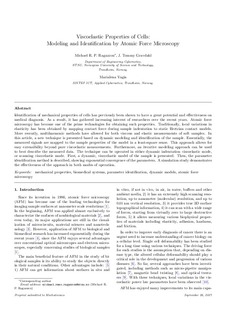Viscoelastic Properties of Cells: Modeling and Identification by Atomic Force Microscopy
Journal article, Peer reviewed
Accepted version
Permanent lenke
http://hdl.handle.net/11250/2477711Utgivelsesdato
2017Metadata
Vis full innførselSamlinger
- Publikasjoner fra CRIStin - SINTEF AS [5801]
- SINTEF Digital [2501]
Originalversjon
10.1016/j.mechatronics.2017.09.011Sammendrag
Identification of mechanical properties of cells has previously been shown to have a great potential and effectiveness on medical diagnosis. As a result, it has gathered increasing interest of researchers over the recent years. Atomic force microscopy has become one of the prime technologies for obtaining such properties. Traditionally, local variations in elasticity has been obtained by mapping contact force during sample indentation to static Hertzian contact models. More recently, multiharmonic methods have allowed for both viscous and elastic measurements of soft samples. In this article, a new technique is presented based on dynamic modeling and identification of the sample. Essentially, the measured signals are mapped to the sample properties of the model in a least-square sense. This approach allows for easy extensibility beyond pure viscoelastic measurements. Furthermore, an iterative modeling approach can be used to best describe the measured data. The technique can be operated in either dynamic indentation viscoelastic mode, or scanning viscoelastic mode. First, a dynamic, viscoelastic model of the sample is presented. Then, the parameter identification method is described, showing exponential convergence of the parameters. A simulation study demonstrates the effectiveness of the approach in both modes of operation.
